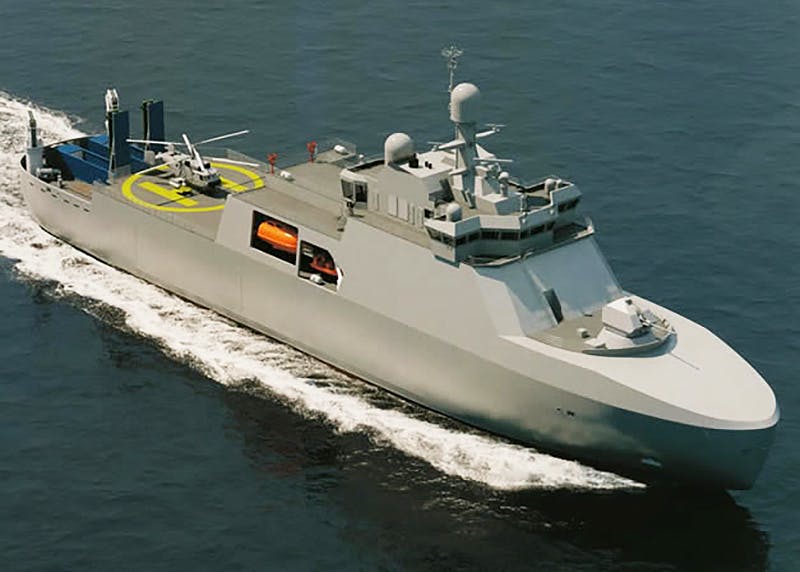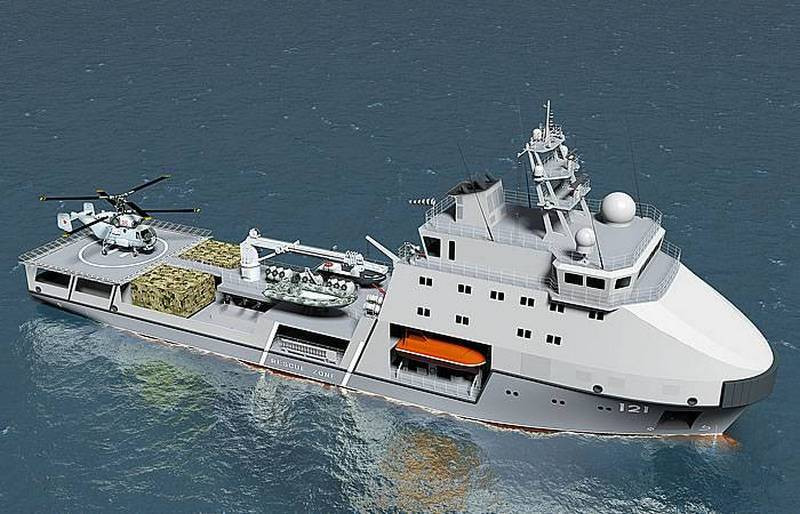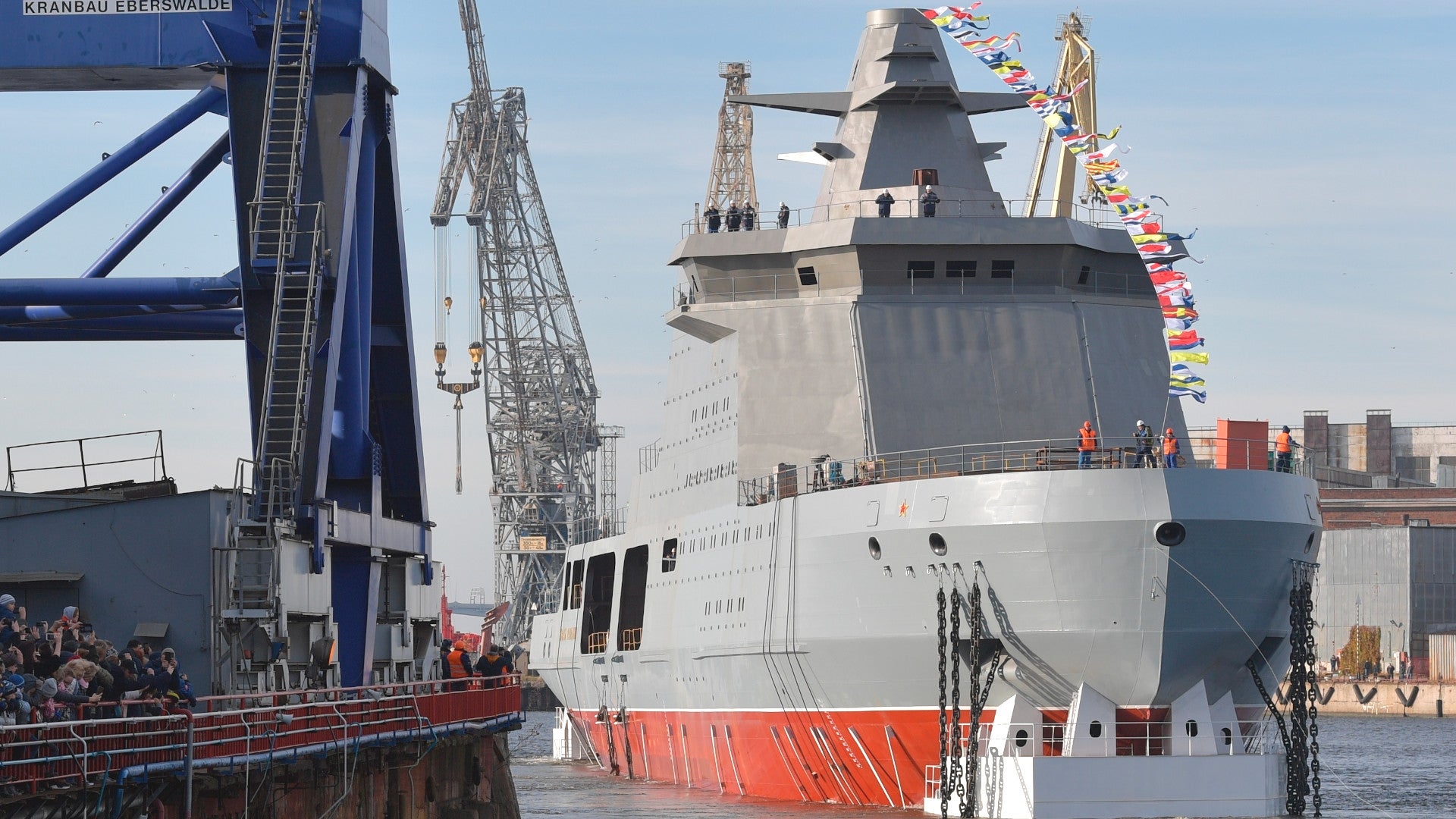A Russian shipbuilding industry official says that the country’s plans for fleets armed icebreakers, such as the Project 23550
Ice class corvettes, are growing and that they may be able to carry more even weapons depending on their exact configuration. This comes nearly three weeks after the launch of the first Project 23550 ship, the Ivan Papanin, which will already be able to carry containerized cruise missile launchers. This ships and others in its class may ultimately have a 100mm main gun, instead of a 76mm one as originally planned, too.
Valery Polyakov, who serves an adviser to the head of Krylov State Research Center, a state-run shipbuilding research and development group, offered the update on Russia’s armed icebreaker plans to state media outlet TASS on Oct. 14, 2019. Krylov, which has also been involved in the development of new, more traditional surface warships, including extremely ambitious amphibious assault ship and aircraft carrier concepts, is set to celebrate its 125th anniversary tomorrow.
“There will be ice-breakers and ice-breaking ships, in other words, ships capable of moving at a sufficient speed through ice floes of [a] certain thickness. In fact, they will be armed icebreakers,” Polyakov. “Where the ice is thin, there will be more weapons and the other way round.”
Polyakov said this latter point was the result of the need to devote more or less mass to ice-breaking reinforcements on different categories of icebreakers. However, he did not name any particular classes of ships or specific weapon systems as examples.
The most obvious example, of course, is the Project 23550 design. Admiralty Shipyards, part of Russia’s state-owned United Shipbuilding Corporation (USC), launched the first of these for the Russian Navy, Ivan Papanin, on Oct. 25, 2019, in St. Petersburg. This same yard expects to lay the keel for the second ship, the future Nikolai Zubov, next year, which it says will also mark the beginning of the production of the serial design with minor, unspecified differences. Vyborg Shipyard, in the town of the same name to the northwest of St. Petersburg, will reportedly build at least two more of these ships for the country’s border patrol, as well.

These 9,000-ton displacement ships can reportedly break through ice up to five and a half feet thick, making a relatively light icebreaker, though still more capable in such an environment than a traditional ship. Heavy icebreakers can push through ice packs up to 10 feet thick, while medium designs are typically described as being only able to pierce through ice up to eight feet thick.
Icebreakers historically have generally not been designed for any real combat, either. Ivan Papanin and its cousins notably have space in the rear specifically for containerized missile launchers capable of firing the Klub and Kalibr anti-ship and land-attack cruise missiles. It is possible that those launchers, or others that fit in the same modular space, will be able to fire other existing or future cruise missiles, as well.

They will also feature an integral main gun in a turret on the bow. Reports had indicated that this would be an AK-176MA 76mm gun. After speaking with Polyakov, TASS reported that the Ivan Papanin and other ships in the class might actually come armed with an AK-190 turret, also known as the A-190, which has an 100mm gun.

The Project 23550s also have a helipad in the rear and at least one previous artist’s conception of the ship shows a Ka-29 armed light transport helicopter onboard. This could give the ships an additional means of engaging hostile threats.

While we don’t know if Polyakov was speaking specifically about the Project 23550 getting additional weapons on top of these systems, it would make sense to do so, if possible, especially if Russia expects these to be more combat-oriented vessels. Even just the installation of a close-in protection system, such as the new Pantsir-ME, which features both command-guided surface-to-air missiles and a pair of six-barrel 30mm rotary cannons, would help shield the ship from incoming threats. Added capabilities could also include non-kinetic systems, such as optical dazzlers now entering service elsewhere in the Russian Navy that are designed to blind and confuse optical seekers on incoming weapons, optical sensors on hostile ships and aircraft, and enemy personnel.

Polyakov may also have been referring to broader plans to consider arming other existing or future icebreakers and other ice-capable ships in the Russian Navy and elsewhere across the country’s security services. Russia already has a notably large icebreaking fleet with approximately 40 of varying sizes, but it is also in the process of building more.
These include the new conventional Project 22600 and nuclear-powered Project 22220 icebreakers and the ice-capable Project 03182 multi-purpose tankers. Russia has already taken delivery of a number of other ice-capable support ships in the Project 20180-series in recent years. None of these ships are armed in their present configuration, but it might be possible to integrate weapons, especially by using containerized systems, onto them later depending on the physical space and power constraints of their respective designs.

Whatever the full size and scope of Russia’s combat- and ice-capable fleets might look like in the end, it is hardly surprising that the country is interested in developing these capabilities given how strategic the Arctic region has become in recent years. Global climate change has already led to a steady reduction in the size of the polar ice cap and shortened the periods of the year where ice presents the greatest risks, which has, in turn, opened up the region to greater activity and geopolitical competition.
Russia, as well as the United States, and to a lesser extent China, among others, has been working hard to expand its military presence in the Arctic and build up additional infrastructure to support growing deployments of ships, aircraft, and ground forces. The United States and others have also begun to express more interest in actual warships better suited to this frigid environment and giving them more firepower, too. There has even been talk in the past about giving the Coast Guard’s new heavy icebreakers a cruise missile capability, as well.
For now, Russia’s Project 23550 ships remain the most visible example of this trend and are likely to be the first to enter operational service. The Russian Navy expects to formally commission Ivan Papanin in 2023, by which time the full extent of its plans for armed icebreakers and other ice-capable ships will have hopefully become clearer.
Contact the author: joe@thedrive.com
